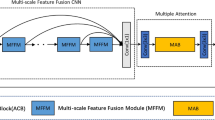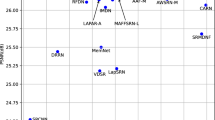Abstract
Since deep learning is introduced into the field of super-resolution (SR), many deep learning-based SR methods have been proposed and achieved good results. At present, most neural networks use ordinary convolution and deeper neural layer in image super-resolution reconstruction in order to achieve better results. Therefore, most existing models have a massive amount of parameters and calculation, which limits the practical application. To solve this problem, in this paper, we propose an efficient feature cheap convolution SR (FCCSR) model, which consists of several multi-level information fusion Blocks (MIFB). In the MIFB, the features are extracted by combining normal convolution and cheap convolution, and the features obtained from each layer of convolution are fused. Under limited parameters and reconstruction speed, it enables the whole model to obtain the features from shallow to deep layers in the low-resolution (LR) images. Secondly, a novel lightweight channel attention module is designed to obtain fewer parameters and better performance. Finally, we add a gradient loss function to the original L1 loss function, making the model pay more attention to the high-frequency part of the LR image and making the reconstructed image’s texture details more straightforward. The experimental results show that the proposed model has reached the most advanced level regarding image quality, memory consumption, parameter number, and calculation amount. The operation speed of FCCSR is roughly the same as that of the current STOA models, and the number of parameters is only 0.63 M. On some data sets, the best performance of FCCSR can be improved by 7%.










Similar content being viewed by others
Data availability
All data, models, and code generated or used during the study appear in the submitted article.
References
Yang X, Liu D, Zhou D, et al. (2018) Super-resolution reconstruction of face images based on pre-amplification non-negative restricted neighborhood embedding[J]. Bulletin of the Polish Academy of Sciences. Technical Sciences 66(6)
Zhu, X., Li, Z., Lou, J., et al.: Video super-resolution based on a spatio-temporal matching network. Pattern Recogn. 110, 107619 (2020)
Al-Janabi, S., Alkaim, A.F., Adel, Z.: An Innovative synthesis of deep learning techniques (DCapsNet & DCOM) for generation electrical renewable energy from wind energy[J]. Soft. Comput. 24(14), 10943–10962 (2020)
Dong, Chao, et al. (2014) Learning a deep convolutional network for image super-resolution European conference on computer vision. Springer Cham
Lim Bee et al. (2017) Enhanced deep residual networks for single image super-resolution. Proceedings of the IEEE conference on computer vision and pattern recognition workshops
Zhang, Yulun, et al. (2018) Residual dense network for image super-resolution. Proceedings of the IEEE Conference on Computer Vision and Pattern Recognition
Zhang, Yulun, et al. (2018) Image super-resolution using very deep residual channel attention networks. Proceedings of the European Conference on Computer Vision (ECCV)
Dai, Tao, et al. (2019) Second-order Attention Network for Single Image Super-Resolution. Proceedings of the IEEE Conference on Computer Vision and Pattern Recognition
Ledig, Christian, et al. (2017) Photo-realistic single image super-resolution using a generative adversarial network. Proceedings of the IEEE conference on computer vision and pattern recognition
Xintao Wang, Ke Yu, Shixiang Wu, Jinjin Gu, Yihao Liu, Chao Dong, Yu Qiao, and Chen Change Loy. Esrgan: Enhanced super-resolution generative adversarial networks. In ECCV, pages 63–79. Springer, 2018
Ma C , Rao Y , Cheng Y , et al. (2020) Structure-Preserving Super Resolution with Gradient Guidance
Han, K., Wang, Y., Tian, Q., et al.: GhostNet More features from cheap operations[C]. Proceedings of the IEEE/CVF Conference on Computer Vision and Pattern Recognition 2020, 1580–1589 (2020)
Szegedy, C., Vanhoucke, V., Ioffe, S., et al.: Rethinking the inception architecture for computer vision[C]. Proc. IEEE Conf. Comput. Vis. Pattern Recognit. 2016, 2818–2826 (2016)
Kim, Jiwon, Jung Kwon Lee, and Kyoung Mu Lee (2016) Accurate image super-resolution using very deep convolutional networks. Proceedings of the IEEE conference on computer vision and pattern recognition
Kim, Jiwon, Jung Kwon Lee, and Kyoung Mu Lee. (2016) Deeply-recursive convolutional network for image super-resolution. Proceedings of the IEEE conference on computer vision and pattern recognition
Lai, Wei-Sheng, et al. (2017) Deep laplacian pyramid networks for fast and accurate super-resolution. Proceedings of the IEEE conference on computer vision and pattern recognition
ZhengHui, X., meiWang, and XinboGao,: Fast and accurate single image super-resolution via information distillation network. IEEE Conference on Computer Vision and Pattern Recognition (CVPR) 2018, 723–731 (2018)
Huang, G., Liu, Z., Weinberger, K.Q.: Densely connected convolutional networks. CoRR 1608, 06993 (2016)
Namhyuk Ahn,Byungkon Kang, and Kyung-AhSohn.2018. Fast, Accurate, and Lightweight Super-Resolution with Cascading ResidualNetwork.InEuropean Conference on Computer Vision (ECCV).252–268
Hui Z, Gao X, Yang Y, et al. (2019) Lightweight image super-resolution with information multi-distillation network[C]. Proceedings of the 27th ACM International Conference on Multimedia 2024–2032
Karen Simonyan and Andrew Zisserman. Very deep convolutional networks for large-scale image recognition. CoRR, abs/1409.1556, 2014. 1, 7
Alex Krizhevsky, Ilya Sutskever, and Geoffrey E. Hinton. Imagenet classification with deep convolutional neural networks. Bartlettetal 48: 1106–1114
Andrew G. Howard, Menglong Zhu, Bo Chen, Dmitry Kalenichenko, Weijun Wang, Tobias Weyand, Marco Andreetto, and Hartwig Adam Mobilenets: Efficient convolutional neural networks for mobile vision applications. CoRR, abs/1704.04861, 2017
Ding, X., Guo, Y., Ding, G., et al.: Acnet: Strengthening the kernel skeletons for powerful cnn via asymmetric convolution blocks[C]. Proceedings of the IEEE International Conference on Computer Vision. 2019, 1911–1920 (2019)
Hwang, J.W., Lee, H.S.: Adaptive image interpolation based on local gradient features[J]. IEEE Signal Process. Lett. 11(3), 359–362 (2004)
Shi, Wenzhe, et al. (2016) Real-time single image and video super-resolution using an efficient sub-pixel convolutional neural network." Proceedings of the IEEE conference on computer vision and pattern recognition
Jie Hu, Li Shen (2018) Samule Albanie and Gang Sun. Squeeze-and-Excitation Networks. In CVPR
Abualigah, L., Diabat, A., Sumari, P., et al.: Applications, deployments, and integration of internet of drones (iod) a review[J]. IEEE Sensors J 21, 2553 (2021)
Roman Zeyde, Michael Elad, and MatanProtter (2010) On single image scale-up using sparse-representations. In International conference on curves and surfaces.Springer 711–730
Abualigah, L., Yousri, D., Abd Elaziz, M., et al.: Aquila optimizer: a novel meta-heuristic optimization algorithm[J]. Comput. Ind. Eng. 157, 107250 (2021)
Jia-Bin Huang, Abhishek Singh, and Narendra Ahuja (2015) Single image super-resolution from transformed self-exemplars. Proceedings of the IEEE Conference on Computer Vision and Pattern Recognition 5197–5206
Matsui, Y., Ito, K., Aramaki, Y., Fujimoto, A., Ogawa, T., Yamasaki, T., Aizawa, K.: Sketch-based manga retrieval using manga109 dataset. Multimedia Tools and Applications 76(20), 21811–21838 (2017)
Dong, C., et al.: Image super-resolution using deep convolutional networks. IEEE Transac Pattern Anal Mac Intell 382, 295–307 (2015)
YingTai, JianYang, and XiaomingLiu (2017) Image super-resolution via deep recursive residual network In IEEE Conference on Computer Vision and Pattern Recognition (CVPR) 3147–3155
Tai, Ying, et al. (2017) Memnet: A persistent memory network for image restoration. Proceedings of the IEEE international conference on computer vision
Zhang K, Zuo W, Zhang L (2018) Learning a Single Convolutional Super-Resolution Network for Multiple Degradations[C]. IEEE/CVF Conference on Computer Vision and Pattern Recognition. IEEE,
Abualigah, L., Abd Elaziz, M., Sumari, P., et al.: Reptile Search Algorithm (RSA): A nature-inspired meta-heuristic optimizer[J]. Expert Syst. Appl. 191, 116158 (2022)
Yu F, Koltun V. Multi-scale context aggregation by dilated convolutions[J]. arXiv preprint arXiv:1511.07122, 2015.
Al-Janabi, S., Alkaim, A.F.: A nifty collaborative analysis to predicting a novel tool (DRFLLS) for missing values estimation[J]. Soft. Comput. 24(1), 555–569 (2020)
Arbelaez, P., Maire, M., Fowlkes, C., Malik, J.: Contour detection and hierarchical image segmentation. IEEE Transac. Pattern Analys. Mac. Intell. 33(5), 898–916 (2011)
Abualigah, L., Diabat, A., Mirjalili, S., et al.: The arithmetic optimization algorithm[J]. Comput. Methods Appl. Mech. Eng. 376, 113609 (2021)
Al-Janabi, S., Alkaim, A., Al-Janabi, E., et al.: Intelligent forecaster of concentrations (PM2. 5, PM10, NO2, CO, O3, SO2) caused air pollution (IFCsAP)[J]. Neural Comput. Appl. 33(21), 14199–14229 (2021)
Jie, L., Tang, J., Gangshan, Wu.: Feature distillation network for lightweight image super-resolution. Springer International Publishing, Cham (2021)
Bevilacqua, M., Roumy, A., Guillemot, C., Alberi-Morel, M.L.: Low-complexity single-image super-resolution based on nonnegative neighbor embedding. Neural Comput Applic 33, 14199 (2012)
Al-Janabi S, Alkaim A (2022) A novel optimization algorithm (Lion-AYAD) to find optimal DNA protein synthesis[J]. Egyptian Informatics Journal
Muqeet, A., et al.: Multi-Attention Based Ultra Lightweight Image Super-Resolution. Springer International Publishing, Cham (2021)
Al-Janabi, S., Mohammad, M., Al-Sultan, A.: A new method for prediction of air pollution based on intelligent computation[J]. Soft. Comput. 24(1), 661–680 (2020)
Mahdi, M.A., AlJanabi, S.: A novel software to improve healthcare base on predictive analytics and mobile services for cloud data centers[C]. International conference on big data and networks technologies. Springer, Cham 2019, 320–339 (2019)
Acknowledgements
This research was supported by the National Natural Science Foundation of China (61573182, 62073164), and by the Fundamental Research Funds for the Central Universities (NS2022041, NS2020025).
Author information
Authors and Affiliations
Contributions
XY contributed to the conception of the study, performed the data analyses and wrote the manuscript; HL performed the experiment, and helped perform the analysis with constructive discussions; XL contributed significantly to analysis and manuscript preparation.
Corresponding author
Ethics declarations
Conflict of interest
All authors declare that they have no conflict of interest.
Ethical approval
I certify that this manuscript is original and has not been published and will not be submitted elsewhere for publication while being considered by “Cluster Computing”. And the study is not split up into several parts to increase the quantity of submissions and submitted to various journals or to one journal over time. No data have been fabricated or manipulated (including images) to support your conclusions. No data, text, or theories by others are presented as if they were our own. The submission has been received explicitly from all co-authors. And authors whose names appear on the submission have contributed sufficiently to the scientific work and therefore share collective responsibility and accountability for the results.
Informed consent
None.
Additional information
Publisher's Note
Springer Nature remains neutral with regard to jurisdictional claims in published maps and institutional affiliations.
Rights and permissions
About this article
Cite this article
Yang, X., Li, H. & Li, X. Lightweight image super-resolution with feature cheap convolution and attention mechanism. Cluster Comput 25, 3977–3992 (2022). https://doi.org/10.1007/s10586-022-03631-1
Received:
Revised:
Accepted:
Published:
Issue Date:
DOI: https://doi.org/10.1007/s10586-022-03631-1




